I’m fascinated by Frank Lloyd Wright, not only because he is arguably one of the nation’s greatest architects, but also because he led a tabloid-worthy life, complete with multiple marriages, mistresses and murder.
So, when Wisconsin dedicated the Frank Lloyd Wright Trail earlier this year in conjunction with his 150th birthday, I knew I had to go.
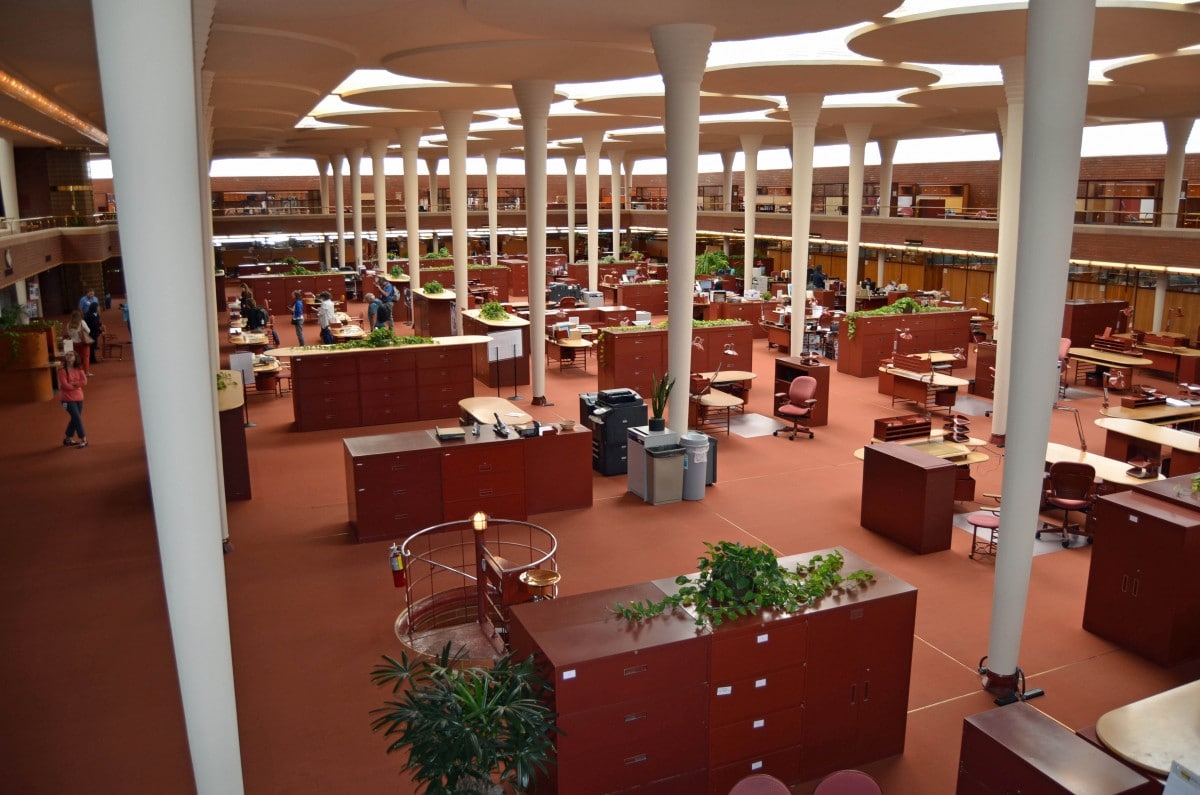
The Great Workroom in the SC Johnson Administration Building. Photo by Teresa Bitler
Frank Lloyd Wright’s SC Johnson Administration Building and Research Tower
The trail begins in Racine, WI, with two of Wright’s most famous works: the SC Johnson Administration Building and the Research Tower. Reservations are required, but the 90-minute tours are free and offer an excellent introduction to Wright’s genius.
Campus tours begin at the Golden Rondelle Theater, the saucer-shaped visitor center which served as the SC Johnson Pavilion at the 1964 World’s Fair. Even though Wright did NOT design it, it’s impressive and still shows the company’s Academy Award-winning documentary, “To Be Alive!,” in the theater.
For many in my group of journalists, hosted by Travel Wisconsin, the highlight was our next stop, the SC Johnson Administration Building. Wright designed everything here down to the three-legged chairs he later had to replace with four-legged ones because they tipped over when secretaries bent down too far.
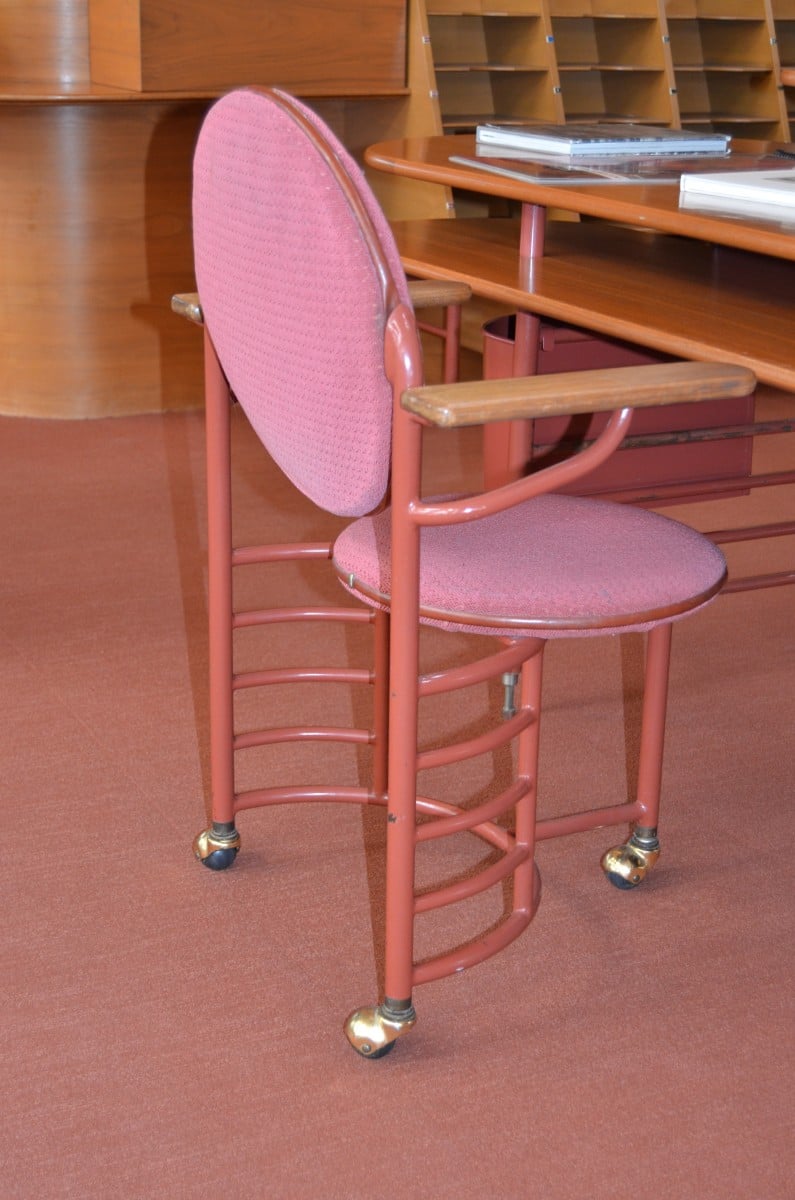
Wright’s three-legged chair. Photo by Teresa Bitler
Like the others, I was wowed by the tree-like dendriform columns in the Great Workroom and the 43 miles of Pyrex glass tubes functioning as windows throughout the building. However, my favorite part of the tour was our next stop—the Research Tower.
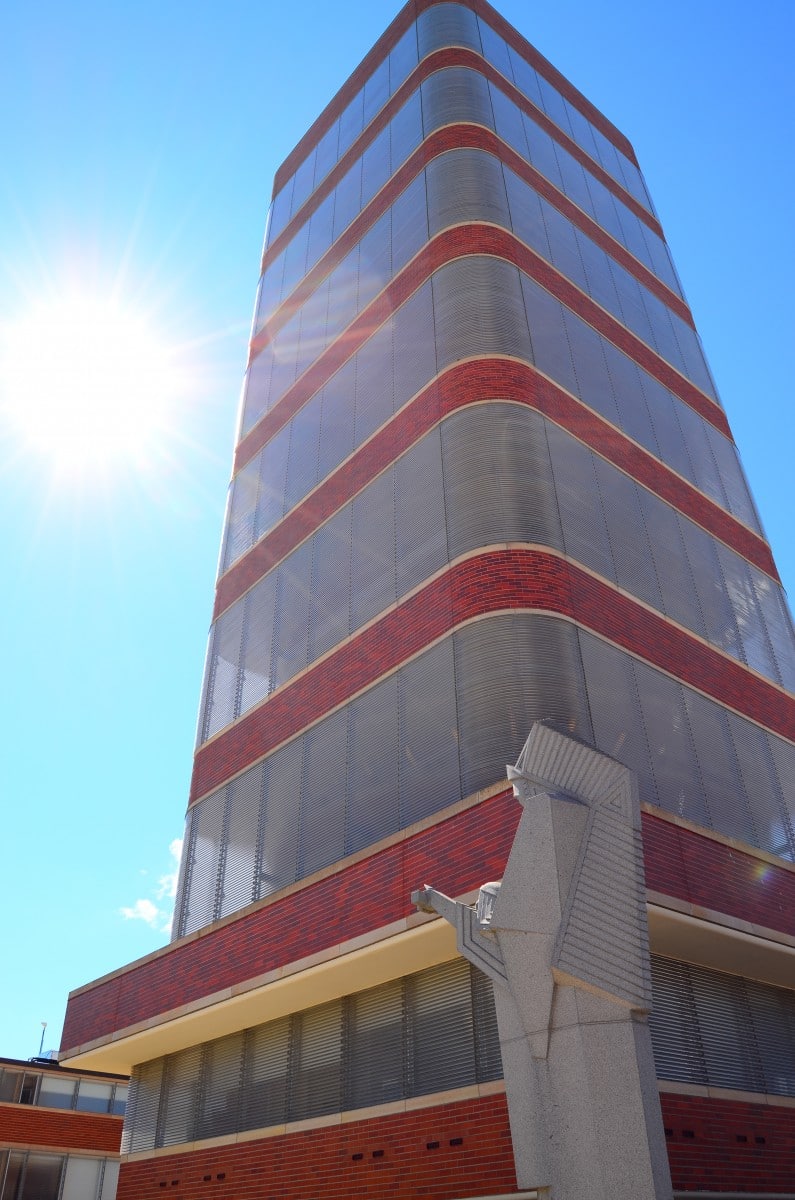
The Research Tower. Photo by Teresa Bitler
Opened in 1950, the Research Tower is one of the world’s tallest cantilevered buildings and the birthplace of products like Raid, Glade, Off!, and Pledge. The tour takes you to a recreated 1950s-era laboratory where you’ll learn about the design dispute over the tiny elevator (Wright won) and see sunglasses worn by employees until curtains could be installed.
Our final stop was the Wright-inspired Fortaleza Hall. Inside are displays on the Johnson family, the company, and Frank Lloyd Wright.
Frank Lloyd Wright-designed Wingspread
You can add a tour of H.F. Johnson, Jr.’s 14,000-square-foot home, Wingspread, to your SC Johnson visit. Located a few miles away, the largest Prairie home Wright designed features a teepee-inspired ceiling, a 30-foot-high chimney with five fireplaces, a glass-enclosed “crow’s nest” lookout, and a cantilevered “Romeo and Juliet” balcony.
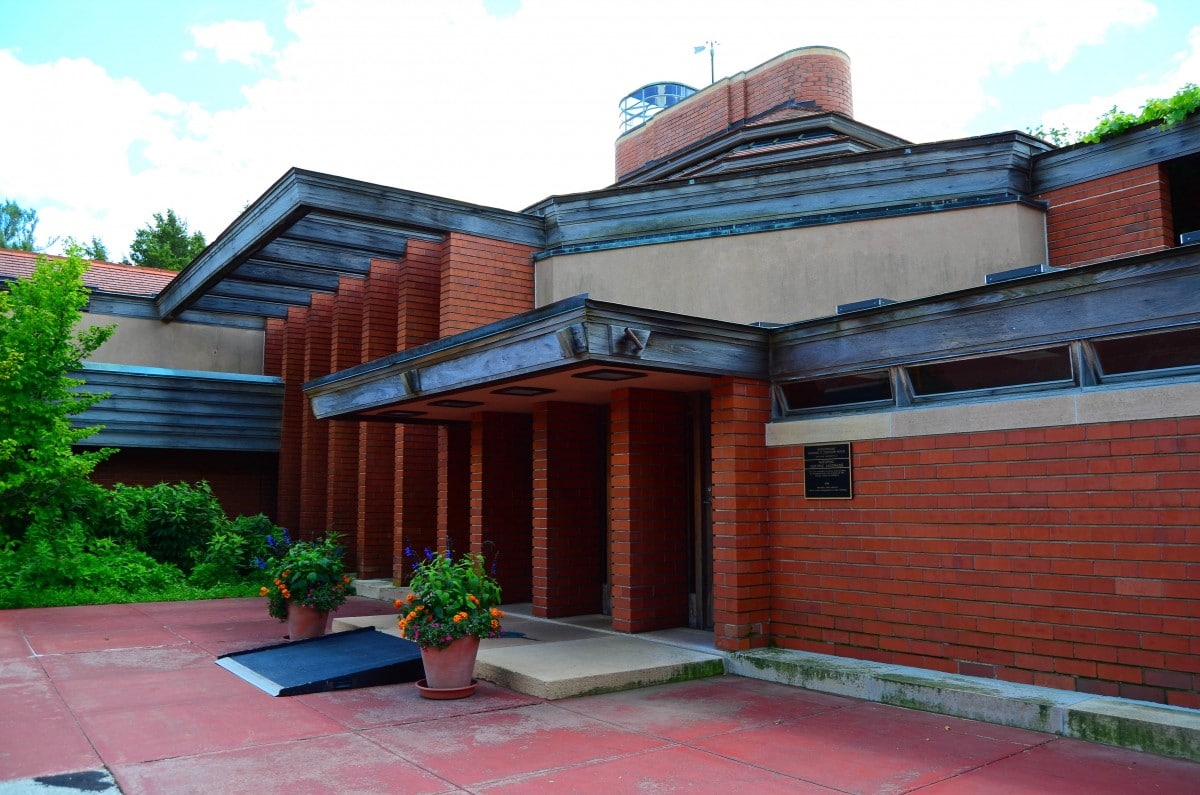
Wingspread, the former Johnson family home. Photo by Teresa Bitler
There are several great Wright stories about the house. One is that Johnson, fed up with the leaky roof, called Wright during a dinner party to complain about the water dripping on his head. Wright instructed him to move his chair loudly enough so the guests could hear.

The “Romeo and Juliet” balcony at Wingspread. Photo by Teresa Bitler
My favorite story, however, is of Wright’s last visit. Mrs. Johnson woke the following day to find that her overnight guest had removed all her personal items and restored the house to his vision. Wright was asked to leave immediately and never invited back.
First Unitarian Society Meeting House
During my visit, we bypassed the trail’s next stop—the Usonian homes in Milwaukee—and headed to Madison, where Wright spent part of his childhood. There, we picked up the trail at the “little country church” he designed for the congregation his father helped found.

First Unitarian Society Meeting House. Photo by Teresa Bitler
Completed in 1951, the First Unitarian Society Meeting House revolutionized church architecture, which to that point had been “rectangular boxes with a cross,” according to our guide. Wright’s design was triangle-based, with interlacing glass and wood front representing praying hands.
You can tour the church Monday through Friday at 10:30 a.m. and 2:30 p.m. from May 1 through September 30 or on Sunday after each worship service throughout the year. Tours are $10 on weekdays; donations are appreciated for Sunday tours.
Monona Terrace
That Wright accepted payment of only $200 in 1939 to design office space for the City of Madison shows how much he wanted to contribute to the community where he once lived. Unfortunately, he never saw what evolved into a convention center jutting 90 feet over Lake Monona; it wasn’t built until 1997.

Monona Terrace. Photo courtesy of Visit Madison
You don’t need a reservation for the daily public tours from 1 p.m., May 1 through October 31. (For the remainder of the year, tours are given Friday through Monday.) Tickets are $5.
Taliesin: The Frank Lloyd Wright Estate
As a teen, Wright was so inspired by views from his uncle’s farm in Spring Green that when adjacent land became available, he convinced his mother to buy it for him. He named the home he built in 1911 Taliesin, meaning “shining brow” in Welsh. Today, Taliesin Preservation manages an 8-acre estate about an hour outside Madison and offers six tours.
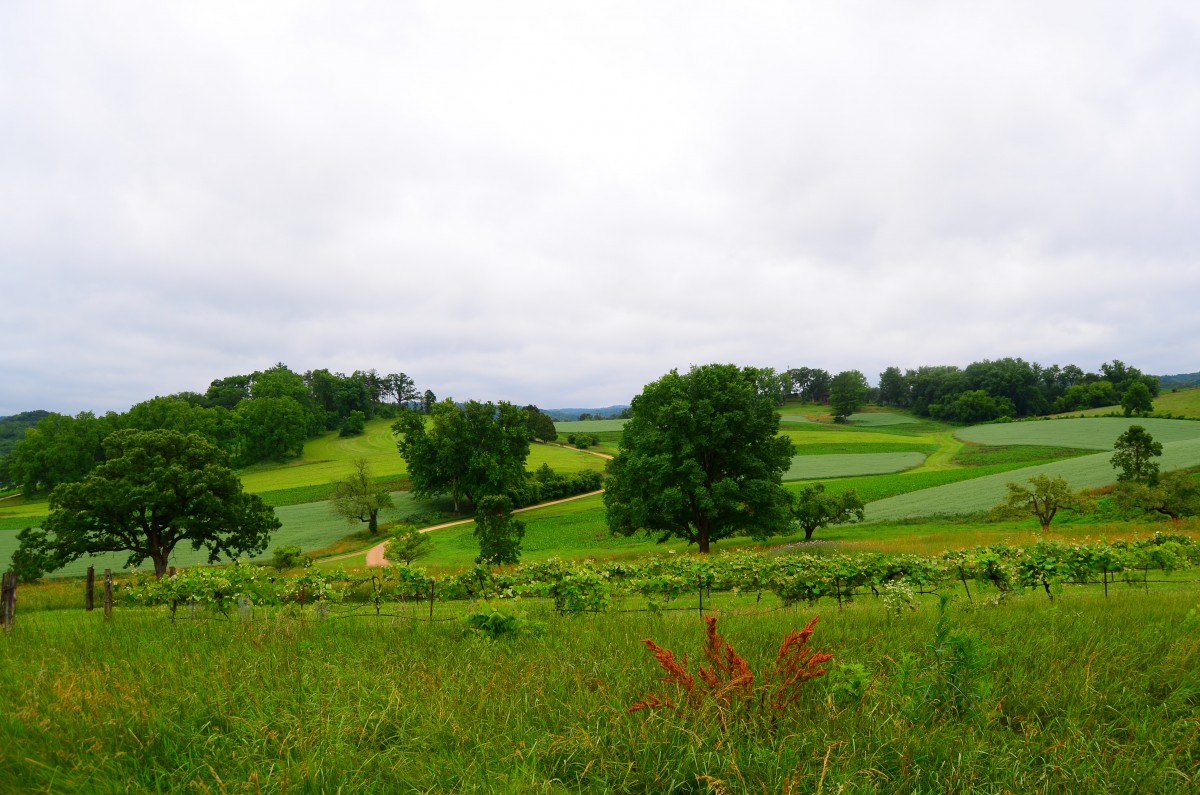
The rolling hills and farmland of Taliesin. Photo by Teresa Bitler
We were given the Estate Tour ($84), which begins at Hillside Studio. Wright designed the building for his aunts in 1902 to house their innovative boarding school. However, in 1932, he converted the abandoned building into a school of architecture that is still used today. On the tour, you’ll see the assembly hall, drafting studio, theater, and maybe a student or two.
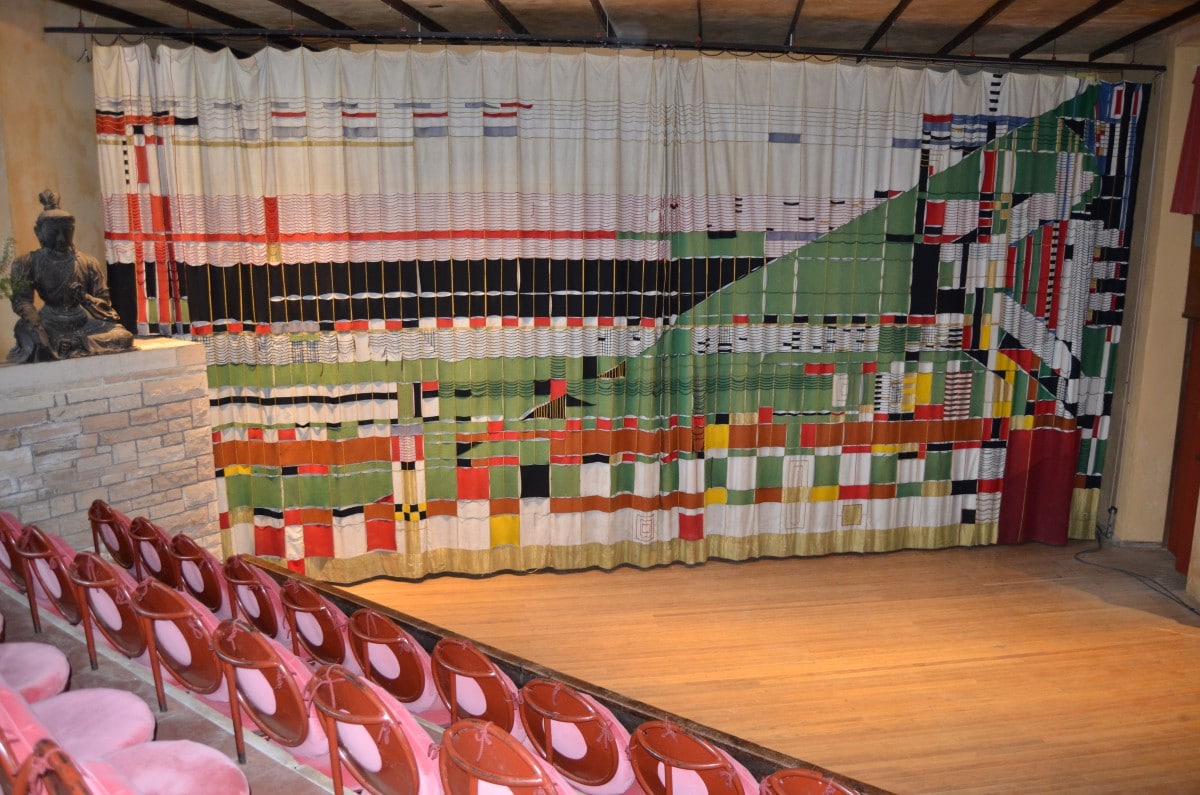
The theater at the Hillside School. Photo by Teresa Bitler
Next, we visited Tan-y-Deri, the Usonian house his sister built. From here, you can get a closer look at Romeo and Juliet, the windmill Wright designed. On the way to Wright’s home, we paused briefly at the Midway Barn and looked over the farmlands.
Taliesin: The Frank Lloyd Wright Home
I loved Taliesin. You don’t have to be a fan of architecture or Wright to appreciate its significance; the stories are fascinating. For example, he built Taliesin after leaving his first wife and their six children for Mamah Cheney, a client’s wife. The aggrieved spouses refused to grant the lovers the divorces they wanted. Since the scandal made living together in Chicago unbearable, Wright built Taliesin.

The cantilever at Taliesin. Photo by Teresa Bitler
Tragedy struck three years later while Wright was working in Chicago. A deranged servant set fire to Taliesin and, as it burned, murdered seven people, including Mamah and her two children, with an axe. You can see evidence of this fire and a subsequent electrical fire looking up into the rafters from the breezeway.
Wright rebuilt both times and, after finally receiving a divorce from his first wife, would remarry twice: once to Miriam Noel, an addict he divorced within four years, and finally to Olgivanna Lazovich Milanoff, the official “Mrs. Wright” of Taliesin.
Wyoming Valley School
Our final stop was the Wyoming Valley School. Wright designed this public school to honor his mother, a county school teacher. He waived his fees, specified concrete to keep costs down, and paid the overage to ensure his neighbors could afford it. (He also purchased two acres of land for the school to build it where he thought it should be built.)

The Wyoming Valley School. Photo by Teresa Bitler
The school building, which now serves as a community arts center, is open for tours Saturday and Sunday, 10 a.m. to 2 p.m., or by special appointment. Donations are appreciated.

Watch for these signs designating the Frank Lloyd Wright Trail. Photo by Teresa Bitler
We didn’t make it to the trail’s final stop in Richland Center, where Wright was born in 1867, but I plan to come back. On my next trip, I plan to visit the A.D. German Warehouse and the Usonian houses in Milwaukee. I would also revisit some of my favorite stops on the Frank Lloyd Wright Trail.
Click here to read more about Frank Lloyd Wright on Wander With Wonder.


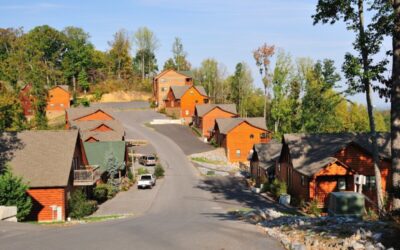


Loved this! I’ve visited Taliesin West but never ventured East to see more of his work. Great photos.
Thanks, Elizabeth! I’ve been to Taliesin West a few times, which is why I wanted to go on this trip…to learn more about him and to see the connections between those buildings and his work here. Definitely go if you have the opportunity.